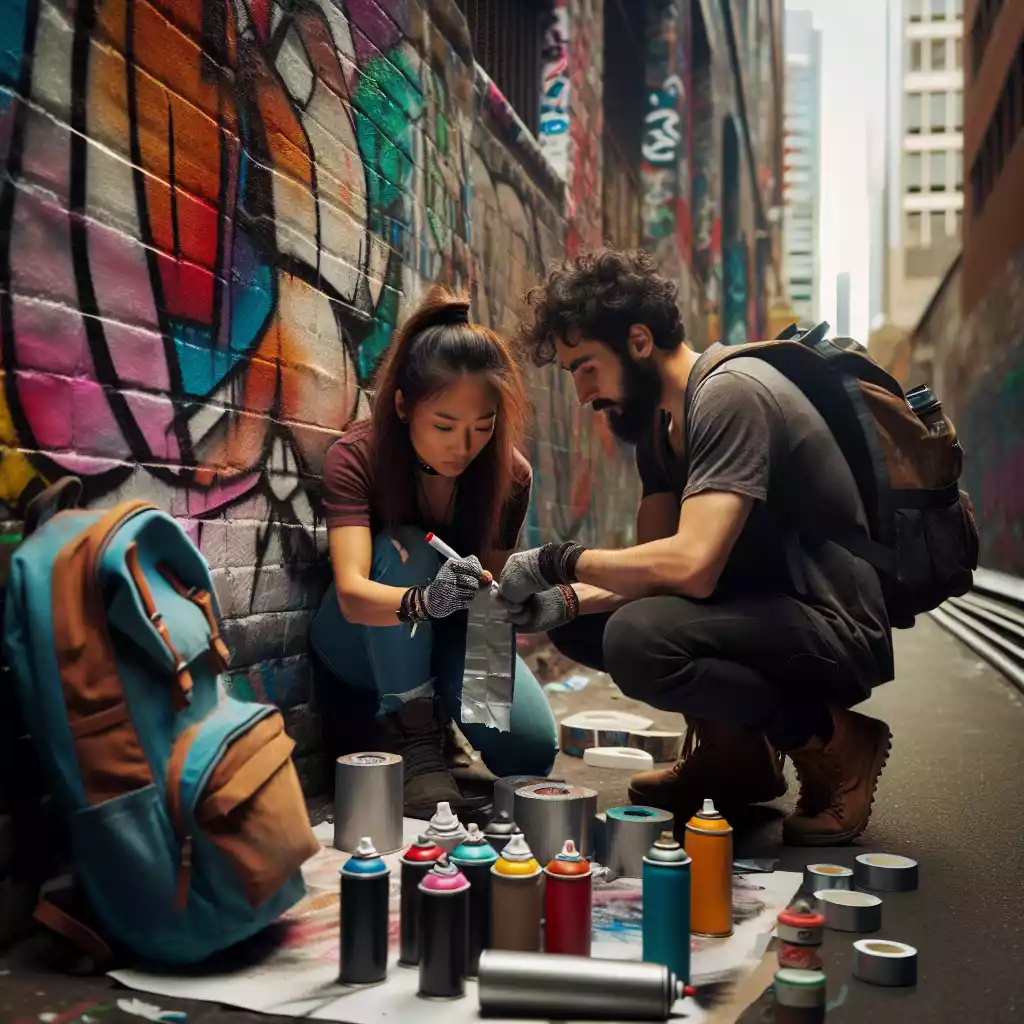Repairing Damaged Stencils During Graffiti Art
There was a time when I found myself in a dimly lit alleyway, ready to create a new piece of graffiti art. I had meticulously designed my stencil, a crucial element of my work, and was excited to bring my vision to life. However, as I unrolled my stencil, I discovered it had suffered a tear. Panic set in. How could I salvage this vital tool? This experience taught me the importance of knowing how to repair damaged stencils, a skill every graffiti artist should master.
Introduction to Stencil Repair
Importance of Stencil Integrity in Graffiti Art
Stencils are the backbone of many graffiti artworks. They allow for precision and repeatability, enabling artists to reproduce complex designs consistently. A damaged stencil can distort the artwork, leading to frustration and wasted time.
Common Causes of Stencil Damage
Stencils can get damaged for various reasons:
– Frequent use: Constant handling can cause wear and tear.
– Improper storage: Folding or crumpling can lead to creases and tears.
– Environmental factors: Exposure to moisture and extreme temperatures can weaken the material.
Tools and Materials Needed for Stencil Repair
Before diving into repair techniques, gather the necessary tools:
– Tape: Masking tape, painter’s tape, or clear adhesive tape.
– Adhesive patches: For reinforcing weak areas.
– Scissors and craft knives: For precision cutting.
– Backing material: Mylar or acetate sheets for added strength.
– Adhesives: Glue sticks or spray adhesive.
Assessing the Damage
Identifying Minor vs. Major Damage
Understanding the extent of the damage is the first step:
– Minor damage: Small tears or weak spots that are easy to fix.
– Major damage: Large rips or missing sections that require more effort to repair.
Determining the Repair Method
Depending on the damage, choose between temporary fixes and permanent solutions.
Temporary Fixes
– Tape: Quick and easy for small tears.
– Adhesive patches: Useful for reinforcing weak areas.
Permanent Solutions
– Reconstructing torn sections: Aligning and gluing edges, then reinforcing with backing material.
– Replacing missing pieces: Creating and attaching new sections.
Repair Techniques for Minor Damage

Using Tape for Small Tears
Tape is a versatile tool for minor stencil repairs.
Types of Tape Suitable for Stencils
– Masking tape: Easy to apply and remove.
– Painter’s tape: Less adhesive residue.
– Clear adhesive tape: Invisible repair.
Step-by-Step Guide to Applying Tape
1. Clean the stencil: Remove any dust or debris.
2. Align the tear: Ensure the edges match perfectly.
3. Apply the tape: Place it on the back of the stencil.
4. Press firmly: Ensure the tape adheres well.
Reinforcing Weak Areas
Weak areas can cause the stencil to break during use.
Applying Adhesive Patches
1. Cut a patch: Use a piece of adhesive material slightly larger than the weak spot.
2. Apply the patch: Place it on the back of the stencil.
3. Press firmly: Ensure it sticks well.
Strengthening with Extra Layers
1. Cut a backing material: Mylar or acetate sheets work best.
2. Glue it: Use spray adhesive for an even application.
3. Press and dry: Allow it to dry completely.
Repair Techniques for Major Damage
Reconstructing Torn Sections
Large tears require more attention.
Aligning and Gluing Torn Edges
1. Align the edges: Match them perfectly.
2. Apply glue: Use a glue stick or spray adhesive.
3. Press and hold: Until the glue sets.
Reinforcing with Backing Material
1. Cut a backing sheet: Slightly larger than the tear.
2. Glue it: Apply adhesive evenly.
3. Press and dry: Ensure a strong bond.
Replacing Missing Pieces
Sometimes, parts of the stencil are lost.
Creating Replacement Sections
1. Trace the missing piece: On a new sheet of stencil material.
2. Cut it out: Use scissors or a craft knife.
Attaching New Pieces to the Stencil
1. Align the new piece: Ensure it fits perfectly.
2. Glue it: Use spray adhesive.
3. Press and dry: Allow it to set completely.
Preventative Measures to Avoid Stencil Damage

Proper Handling and Storage
Taking care of stencils prevents future damage.
Rolling vs. Folding
– Rolling: Prevents creases and folds.
– Folding: Can cause permanent damage.
Protective Covers and Cases
– Plastic sleeves: For individual stencils.
– Hard cases: For multiple stencils.
Using Durable Materials for Stencils
Choosing the right material can extend the stencil’s life.
Choosing the Right Material
– Mylar: Durable and flexible.
– Acetate: Strong and easy to cut.
Benefits of Mylar and Acetate
– Mylar: Resistant to tearing and chemicals.
– Acetate: Clear and easy to clean.
Advanced Repair Techniques
Laser Cutting for Precision Repairs
For intricate designs, laser cutting can be a lifesaver.
Accessing Laser Cutting Services
– Local print shops: Often offer laser cutting.
– Online services: Convenient and precise.
DIY Laser Cutting at Home
– Laser cutters: Available for home use.
– Software: For precise design adjustments.
Digital Restoration and Reprinting
Sometimes, digital solutions are the best.
Scanning and Editing Damaged Stencils
1. Scan the stencil: Use a high-resolution scanner.
2. Edit digitally: Use software like Adobe Illustrator.
Printing New Stencils from Digital Files
1. Print the design: On stencil material.
2. Cut it out: Using a craft knife or laser cutter.
Tips and Tricks for Successful Stencil Repair
Working in a Clean Environment
A clean workspace ensures better results.
Patience and Precision in Repairs
Take your time to align and glue edges perfectly.
Testing Repairs Before Use
Always test the stencil on a scrap surface first.
Case Studies of Stencil Repairs
Real-Life Examples from Graffiti Artists
Graffiti artists often share their repair stories.
Lessons Learned and Best Practices
Learning from others can save you time and effort.
Resources for Stencil Repair
Online Tutorials and Guides
– YouTube: Great for visual learners.
– Blogs: Step-by-step instructions.
Recommended Tools and Suppliers
– Art supply stores: For quality materials.
– Online retailers: Convenient and often cheaper.
Community Forums and Support Groups
– Reddit: r/Graffiti and r/StencilArt.
– Facebook groups: For advice and support.
FAQs
Q1: What is the best tape for stencil repair?
A1: Masking tape and painter’s tape are ideal due to their easy application and removal.
Q2: Can I use regular glue for stencil repairs?
A2: Yes, but spray adhesive provides a more even application and stronger bond.
Q3: How do I store my stencils to prevent damage?
A3: Roll them instead of folding and use protective covers or cases.
Q4: Is it worth investing in a laser cutter for stencil repairs?
A4: If you frequently repair intricate designs, a laser cutter can be a valuable investment.
Q5: Can I repair stencils made of any material?
A5: Most repairs work on Mylar and acetate, but some materials may not adhere well to tape or glue.
Conclusion
Repairing damaged stencils is an essential skill for graffiti artists. By assessing the damage, choosing the right repair method, and using the proper tools, you can extend the life of your stencils and ensure your artwork remains precise and beautiful. Remember to handle and store your stencils properly to prevent future damage, and don’t hesitate to explore advanced techniques like laser cutting and digital restoration. Happy stenciling!
How To Repair A Old or Broken Stencil
Ruth Aquilani is a renowned graffiti artist known for her bold, colorful, and expressive style. She began her career as a street artist in the early 2000s, quickly making a name for herself in the graffiti community with her unique and striking works of art.
